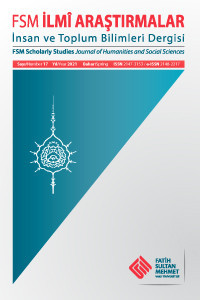et-Tabâtabâî’nin Mîzân Tefsiri’nde Uyguladığı Cery Kavramının Arka Planı
İsnâaşeriyye/İmâmiyye/Câferiyye Mezhebi’nin hadis kitapları ve rivâyet tefsirlerinde
âyetleri imamlar, taraftarları ve onların düşmanları sayılan kimselerle ilişkilendirilen
birçok rivâyet bulunmaktadır. Modern dönem İsnâaşeriyye müfessirlerinden Muhammed
Hüseyin et-Tabâtabâî (1904-1981) rivâyetlerdeki bu irtibâtı, geliştirdiği cery kavramıyla
açıklamaktadır. Bu çalışmada onun cery kavramını uygulayarak ortaya koyduğu âyet yorumlarının,
âyet-rivâyet uygunluğu açısından analizi ve eleştirisi yapılmıştır. Ayrıca onu
bu kavramı, Şiî-usûlî ulûmu’l-Kur’ân’ına üst bir başlık olarak kazandırmaya sevk eden
âmiller bulunmaya çalışılmıştır. Buna göre teorik açıdan ilgili kavrama yüklenen anlamın
âyet yorumlarına yansımadığı ve bunun arkasında mezhep taassubunun olduğu anlaşılmıştır.
Bu tutumuyla onun, İsnâaşeriyye rivâyet edebiyatında önemli bir yekûn tutan
söz konusu rivâyetleri muhâfaza etme çabası içine girdiği tespit edilmiştir. Diğer yandan
onun, bâtıni anlam ile te’vîl kavramını da bu amaca yönelik düşündüğü fark edilmiştir.
Anahtar Kelimeler:
Tefsir, cery, âyet, et-Tabâtabâî, Mîzân Tefsiri
The Background of the Concept Al-Jary Applied by Al-Tabatabai in the Qur’anic Exegesis
There are various narratives that associate the verses with the Imams and the ones considered
their supporters and their enemies in the narrative interpretation and hadith books
of the Ithna ‘Ashariyyah/Imamiyyah /Jafariyyah sects. Muhammad Husayn Tabâtabâî
(1904-1981), the contemporary Ithna ‘Ashariyyah commentator, explains this association
in the narratives with the concept of Al-Jary he developed. In this study, the analysis and
the critique of the interpretations of the verses he put forward by applying the concept
Al-Jary, was made from the perspective of verse-narrative compatibility. Additionally,
the factors that impelled him to bring in this concept to the Shi’a-Usuli Qur’anic Sciences
were tried to find out. As a result, it was understood that the meaning theoretically
assumed to the verses was not reflected to the interpretation of the verses and the drive
behind this approach was sectarian fanaticism. It was found out that he sank himself into
the effort of preservation of the narratives that constitute an important amount in the Ithna
‘Ashariyyah literature of the narratives. On the other hand, it was noticed that he considered
the esoteric (batıni) meaning and the concept of implicity (ta’wil) to support his aim.
Keywords:
Interpretation, al-jary, verse, Al-Tabatabai, Tafseer al-Mizan,
___
- el-´Ayyâşî, Muhammed b. Mesud, Tefsîrü’l-´Ayyâşî, thk. Komisyon, Kum, Müessesetü’l-Bi´se, 1421h.
- el-Esterâbâdî, Muhammed Emin, el-Fevâidü’l-Medeniyye (eş-Şevâhidü’l- Mekkiyye ile beraber), thk. Komisyon, y.y., y.y., t.y.
- el-Esterâbâdî, Seyyid Şerefüddin Ali el-Hüseynî, Te’vîlü’l-Âyâti’z-Zâhire fî Fezâli’l-‘Ireti’t-Tâhire, thk. Hüseyin el-Estâdûlî, Kum, Müessetü’n-Neşri’l-İslâmî, 1409h.
- ISSN: 2147-3153
- Başlangıç: 2012
- Yayıncı: Fatih Sultan Mehmet Vakıf Üniversitesi
Sayıdaki Diğer Makaleler
Güney Amerika Dekolonyal Düşüncesinin Temel Kavramları, Vaatleri ve Sınırları
Muhammed Mustafa el-Aʿzami, On Schacht’s Origins of Muhammadan Jurisprudence
V. I. Rassadin, Kartinnıy Slovar’ Soyotskogo Yazıka
Stephen J. Lee, Avrupa Tarihinden Kesitler 1494-1789, çev. Ertürk Demirel
et-Tabâtabâî’nin Mîzân Tefsiri’nde Uyguladığı Cery Kavramının Arka Planı
